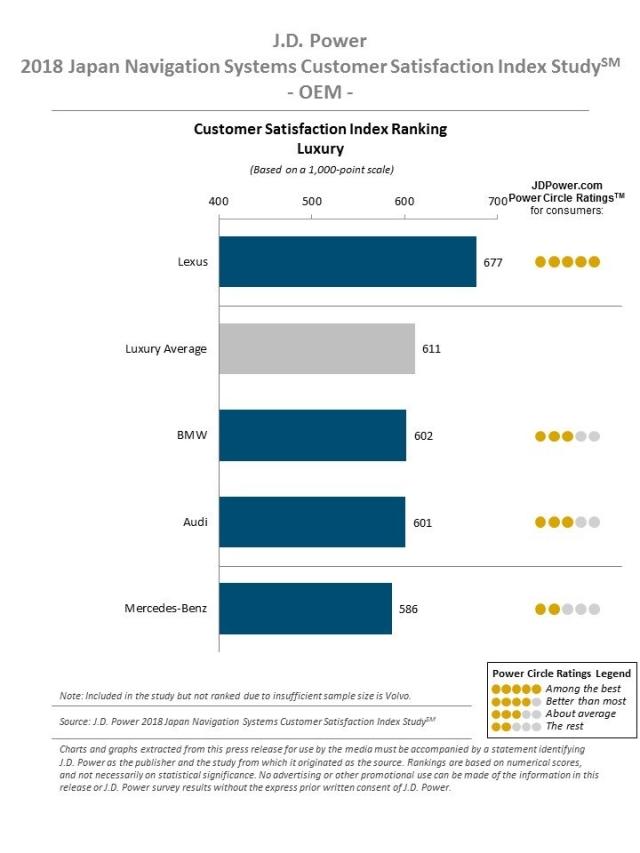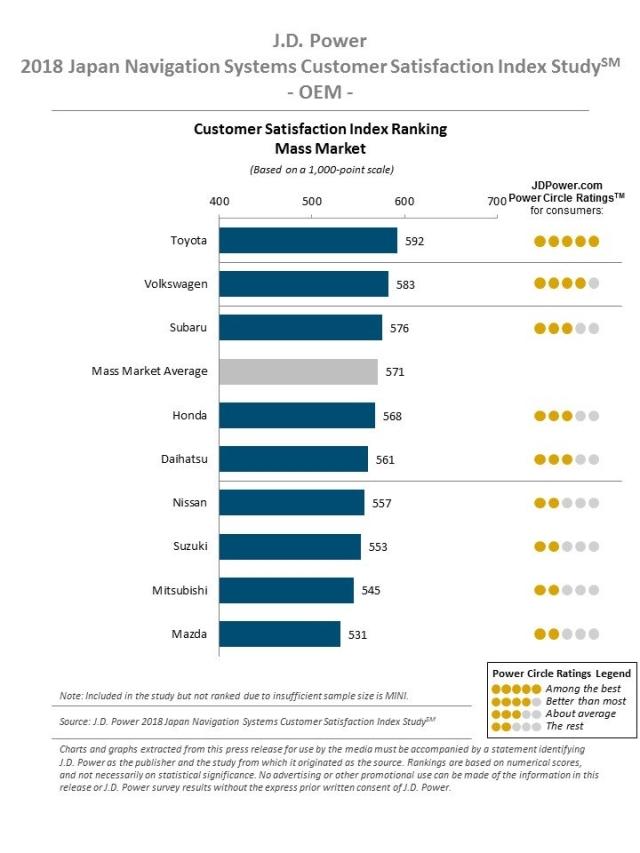Manufacturer Focus on Content Creation and Improved Voice Operation in Vehicle Navigation Systems Key to Increased Use of Connectivity Functions, J.D. Power Finds
Lexus Ranks Highest in Navigation Satisfaction among Luxury Brands, Toyota Ranks Highest among Mass Market Brands
TOKYO: 5 Oct. 2018 — Improvement in performance and operability of navigation system voice operation is key to customer satisfaction, according to the J.D. Power 2018 Japan Navigation Systems Customer Satisfaction Index StudySM—OEM, released today.
Now in its 11th year, the study measures satisfaction with factory- and dealer-installed navigation systems. The redesigned study adds two new factors relating to design elements and connectivity functions, bringing the number of examined factors to six (listed in order of importance): navigation function (23%); display screen (19%); audio and video function (18%); ease of use (17%); design and texture (16%); and other functions, apps, and services (6%). Satisfaction is calculated on a 1,000-point scale.
“A navigation system significantly improves a vehicle’s appeal, generating new values by providing owners with additional connectivity functions and services,” said Yuji Sasaki, Director of the Automotive Division at J.D. Power. “As a hi-tech environment, it is necessary that new navigation system features are being created and ongoing content creation and functions should become a focus for manufacturers. Additionally, as navigation systems become increasingly sophisticated, it is important they also channel energy in keeping these upgrades user-friendly and intuitive.”
Following are some key findings of the study:
- Availability of telematics services or smartphone connections increases customer satisfaction: Every year, an increasing number of vehicle navigation systems are equipped with connectivity functions, such as telematics services and smartphone connections. While overall navigation system satisfaction averages 574 points this year, among customers who use telematics services or smartphone connections, satisfaction is 38 points higher, averaging 612 points. This suggests that a focus on these areas is key to improving customer satisfaction.
-
Manufacturers should communicate advantages of using new content and features: 68% of the navigation systems are connected to communication devices, such as on-board Data Communication Modules (DCM) and smartphones. However, because only 27% of vehicle owners use these telematics services or smartphone connections, which need a connection to the Internet, it indicates that many vehicle owners only use the hands-free phone function or play music stored in their smartphone. This suggests that customers are not using the connectivity functions or services in their vehicle or that the advantages of such functions have not been clearly communicated to vehicle owners. To establish a competitive advantage, it is important for manufacturers to continue efforts toward the development of connectivity functions and services that increase the likelihood that customers will use them, and thereby increasing the appeal of their models in the marketplace.
-
Customers are interested in and expect voice operation: The study also examines the use of navigation system voice operation (either a voice recognition feature or via an operator). Only 13% of owners use the voice operation function to operate their navigation system. However, among customers who want to continue to use their on-board navigation system, 26% cite voice operation as the most preferred operation. This suggests high customer interest and expectations to operate a navigation system through voice.
-
Improvement in performance and operability of voice operation is imperative: Improvement in performance and operability of voice operation are of high importance. For example, approximately 30% of owners complain about or report problems with traditional modes of operation, such as the use of touchscreens or controllers, and the proportion rises to 55% for voice operation. Among owners who use the voice operation function, 32% say that they gave up using this function at least once of every two attempts because of low performance.
-
The experience of problems with voice operation strongly correlates with satisfaction: The study finds that the correlation between complaints or experiencing problems and customer satisfaction is higher for voice operation than for traditional operations, such as the use of touchscreens or controllers. This suggests that improving this function is important for increasing customer satisfaction.
Study Rankings
Luxury Segment: Lexus ranks highest with a score of 677. Lexus performs above the industry average in all six factors, and particularly well in navigation function and ease of use. Lexus is followed by BMW (602) and Audi (601).
Mass Market Segment: Toyota ranks highest with a score of 592. Toyota performs particularly well in navigation function and other functions, and in apps and services, while the highest levels of satisfaction are in audio and video function and ease of use. Toyota is followed by Volkswagen (583) and Subaru (576).
The 2018 Japan Navigation Systems Customer Satisfaction Index Study—OEM is based on responses from 966 luxury vehicle owners and 6,234 mass market vehicle owners who purchased a new vehicle equipped with a factory- or dealer-installed navigation system from April 2017 through March 2018. The survey was conducted via internet and was fielded in July 2018.


